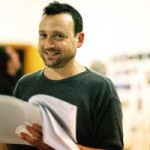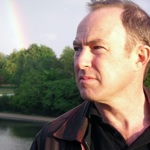Achtung!
If you read something contrary here previously, consider this an update. The Lily Pad in Cambridge has been closed temporarily to obtain proper codes and licenses; they hope to re-open soon. Therefore, the Earle Brown FOLIO event scheduled for tomorrow night, Oct. 20, by the Callithumpian Consort will be rescheduled on a future date.
* * * * *
One conclusion that a body might draw from the Callithumpian Consort’s outing last week in Boston is that what some contemporary music needs — and richly deserves — is a near-empty concert hall.
No, seriously. Would Earle Brown’s “Sign Sounds” and John Luther Adams’s “songbirdsongs” have been anywhere near as atmospheric if the New England Conservatory’s Jordan Hall had been — sickening thought — full? Ah we happy few, all forty (40) of us.
The point comes up because of the way that “songbirdsongs” in particular relies, first, on silence, both in itself and as background; and second, on space, not just in the sense of there being a sort of aerating nimbus around the sounding notes (i.e., good acoustics) but room enough, measured in linear feet, for a pair of piccolo players to go wandering about inside and outside the auditorium making like birds.
These weren’t Messiaen birds, they were Adams birds. A nice thing about an Adams bird, if one can generalize, is that if it feels like modulating a bit that’s what it will do — just a little. And that’s as far in the direction of grandiosity as they ever get. Jordan Hall being three storeys high and with lots of doors to enter and depart from, there was a blessed abundance of perches.
So described, “songbirdsongs” might have you wondering about what’s been helpfully labeled the Cringe Factor. Yes, the titles that the piece’s sections bear — “Morningfield Song,” “Apple Blossom Round,” “Wood Thrush,” “Joyful Noise,” “notquitespringdawn,” “Mourning Dove,” “Meadowdance,” “August Voices” — do suggest a New Agey niceness that will not appeal to all tastes. And there were moments when you felt the composer was really pushing it (must all this be so calm, sparse, and Alpha-wavey?) but then what should land on us but an expertly timed, shock-cut, irruptive coup de theatre — so that’s what all those percussionists were on hand for.
Forget about the Cringe Factor then. Cumulatively, there turned out to be a much greater variety of tone color and strategy in “songbirdsongs” than might first have appeared. Examples: the quiet vibraphone roll teetering on the edge of audibility — you had to crane to see where it was coming from — that produced the oddest, near-electronic sort of hum; “Mourning Dove,” with its literalist sighing bent notes; the “Apple Blossom Round”; and the noisy bits, which in this context had the feel of natural disturbances.
How much of this sort of thing is too much? Reactions will differ, but evidently not a very great deal. “Relaxing but not insignificant” (John Schaefer) is one take on Adams’s music, “You either love it or like it” (Evan Johnson) another.
Finally, a matter we’re not exactly sure that the composer consciously intended. Toward the end of “songbirdsong,” as event placidly succeeded event, your reviewer became aware of a steady, silent pulse beneath it all — something like 50 ticks to the minute. The instrumental attacks were variously on or to either side of the pulse, but mostly on. It was there, wasn’t it? Or was it the brain that was supplying it? Or both?
The performers, excellent all, were: Nana Aomori, Jessi Rosinski (piccolos), Jeffrey Means. George Nickson, Joseph LaPalomento, Daniel Zawodniak (percussion), Stephen Olsen (celesta), Gabriel Diaz (violin).
* * * * *
Earle Brown’s “Sign Sounds,” which mobilized some 18 players plus conductor, raised certain questions if you thought about them as the music was going on, but somehow didn’t if you didn’t. The questions would have been: What, precisely, is in that score, and of what kind and how much, and did it matter?
It’s irresistible to quote Paul Griffiths, that indefatigible and learned pro, on the subject of Brown’s music:
“His aim was not the empty space of Cage, nor the quiet space of Feldman, but the decisive object — not the extinction of the composer, nor the liberation of the performer, but the creation of a well-made piece, one that would have a sure identity for all the variability of form and detail introduced by means of indeterminate notation. The more indeterminate the notation, the more the identity of the piece would have to be visual …”
— “Modern Music and After: Directions Since 1945” (Oxford University Press, 1995).
In this particular performance of “Sign Sounds” there was a sense of the piece being assembled and set up out of blocks of air, right there in front of you — and in that loveliest of musical work places, Jordan Hall. How everything did sound — the sprinklings of celesta, some very in-tune string harmonics, the lyre-like punctuations of the harp, a swinging brass choir, and the quartet of mallet-wielding percussionists who, when the texture allowed, created one doozey of a great splash (like New York Modernist flung paint? Just a thought.)
Near-stasis then a flutter of activity — it was at these extremes, it seemed, that all these colorful sonic possibilities were being realized. At one point a series of staggered entrances had you listening for, of all things, a fugue. A fugue! But shouldn’t ghostly traces of such things be appearing in Brown? His worklist does include after all, though from early on, a fugue and a passacaglia.
In any event, the piece went over like you wouldn’t believe (40 pairs of hands clapping, all belonging to the right people), and there was an encore: a fragment of what had gone before, sounding pretty much as we’d heard it the first time.
The heroes and heroines of this performance were: Jessi Rosinski (flute), Will Amsel (clarinet), Amy Advocat (bass clarinet), Adam Smith (bassoon), Andrew Stetson (trumpet), Dylan Chmura-Moore (trombone), Hester Ham (piano), Minji Noh (celesta), Franziska Huhn (harp), Ethan Wood and Heather Wittels (violins), Ashleigh Gordon (viola) David Huckaby (cello), David Goodchild (bass), Jeffrey Means, John Andress, Joseph Becker, William Holden (percussion) and Stephen Drury (conductor).
* * * * *
First on the program was Alvin Lucier’s “Ever Present,” which as a late arriver (accursed Harvard/Dudley bus) we were reduced to experiencing from outside one of the windowed doors leading in to the auditorium. The flutist, sax player, and pianist all looked quite at peace with themselves, not having very many notes to play and perhaps for other reasons as well. Anyway, we didn’t hear any. But wait, was it the overhead lighting in the corridor that was giving off that high-pitched technological noise? Or ventilation gone haywire? No, silly, it was one of Lucier’s beloved electric gizmos.
RICHARD BUELL can be reached at rbuell@verizon.net

 The 52nd Annual Grammy Awards are on Sunday night,
The 52nd Annual Grammy Awards are on Sunday night, 


